Zoom
Trash

De minuscules organismes échappent à la vie au microscope dans des marionnettes surdimensionnées par Judith Hope. Website der Künstlerin Eva-Maria Lopez. Agnes-meyer-brandis//new news. Ausstellung: "Das Ende des 20.
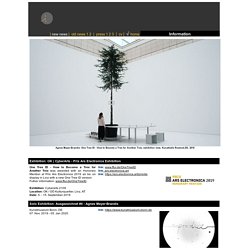
Jahrhunderts. Es kommt noch besser. Ein Dialog mit der Sammlung Marx" Datum: 14. September 2013 - 30. März 2014 Eröffnung: Freitag 13. Mit Arbeiten von: Özlem Altin, Joachim Bandau, Brigitte Bardot, Sara Barker, Wesley E. Evolution du laboratoire conceptuel Isis. Accueil. Špela Petrič. Marine Nouvel. Betty Beaumont. Betty Beaumont (born January 8, 1946) is a Canadian-American site-specific and conceptual installation artist, sculptor, and photographer.
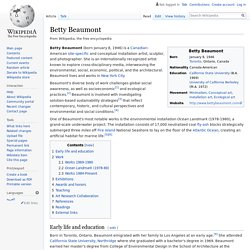
She is an internationally recognized artist known to explore cross-disciplinary media, interweaving the environmental, social, economic, political, and the architectural. Beaumont lives and works in New York City. Beaumont's diverse body of work challenges global social awareness, as well as socioeconomic[1] and ecological practices.[2] Beaumont is involved with investigating solution-based sustainability strategies[3] that reflect contemporary, historic, and cultural perspectives and environmental and social conditions.[4] Laboratoires BioArt. Kac's show at Oi Futuro, Rio de Janeiro. Curated by Christiane Paul -- Read the curator's essay Oi Futuro, Rio de Janeiro, Brazil (January 25th to March 30th, 2010) Photos: Beto Felicio (unless otherwise noticed).
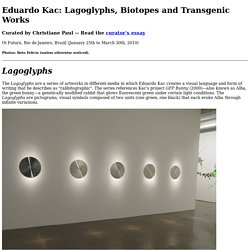
The Lagoglyphs are a series of artworks in different media in which Eduardo Kac creates a visual language and form of writing that he describes as "rabbitographic". The series references Kac's project GFP Bunny (2000)—also known as Alba, the green bunny—a genetically modified rabbit that glows fluorescent green under certain light conditions. The Lagoglyphs are pictograms, visual symbols composed of two units (one green, one black) that each evoke Alba through infinite variations. Eduardo Kac, Lagoglyphs : The Lepus Constellation Suite (2009) 5 engraved and painted steel discs (20 inches diameter each) with lagoglyphic interstellar messages transmitted to the Lepus Constellation on March 13, 2009 from Cape Canaveral, Florida. Disc #1 is in the collection of Alfredo Herzog da Silva, São Paulo. BIO ART. Natural History of the Enigma (2003/08) -- The central work in the "Natural History of the Enigma" series is a plantimal, a new life form Kac created and that he calls "Edunia", a genetically-engineered flower that is a hybrid of Kac and Petunia.
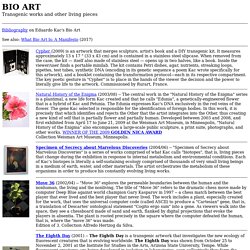
The Edunia expresses Kac's DNA exclusively in the red veins of the flower. The gene Kac selected is responsible for the identification of foreign bodies. Julie C. Fortier. Sissel Tolaas : odeurs de trouble. Art & Olfaction - L’odeur encensée. Ils sont si peu nombreux à s’être intéressés dans la littérature à l’odorat que leurs noms reviennent telles des antiennes dans tous les ouvrages qui traitent des fragrances.
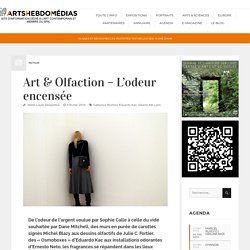
Qu’ils soient spécialisés ou de vulgarisation. Citons donc : Charles Baudelaire (1), Joris-Karl Huysmans (2), Marcel Proust (3), Italo Calvino (4) et Patrick Süskind (5). Au premier, nous devons Le Flacon au « souvenir enivrant qui voltige » ; au deuxième, Jean des Esseintes, un antihéros qui prétend que sentir peut procurer autant de jouissance que voir ou écouter ; au troisième, le fameux « effet madeleine » ; au quatrième, un homme qui cherche à identifier une femme à l’aide de son seul parfum et, au cinquième, Jean-Baptiste Grenouille, personnage effrayant qui ne vit que par l’odeur.
Bien entendu et sans aucun doute, cette petite liste n’est pas exhaustive et ne vaut que par le nombre incroyable de textes qui lui empruntent ses références. Un sens longtemps inconvenant Le tournant du XXe siècle. Quelle est cette odeur dans la cuisine? Arts Olfactory Turn - L'art en Amérique. Smell is rarely utilized in the realm of contemporary visual and performance art, but that wasn’t always the case.
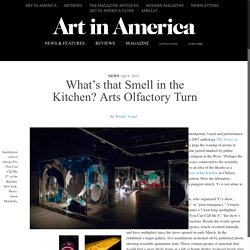
In the 2007 anthology The Senses in Performance, dance historian Sally Banes pegs the waning of aroma in theater to the turn of the 20th century, a time period marked by public hygiene campaigns and a turn away from religion in the West. “Perhaps the deodorization of the theater was in some ways connected to the scientific ambitions of naturalism,” Banes writes, “to an idea of the theatre as a sanitized laboratory.” Le Guggenheim présente un opéra à renifler - Le New York Times. PATTERN OF ACTIVATION (LOKI’S CASTLE) Molecular Sculpture – Art in America.
Chemical and biological processes open the encounter with artwork to nonvisual modes of sensation.
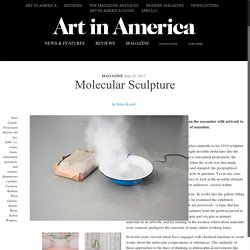
BY PRESENTING AN empty-looking glass ampoule as his 1919 sculpture 50 cc of Paris Air, Marcel Duchamp brought invisible molecules into the purview of sculpture. The work is not just a conceptual proposition; the ampoule actually did contain Parisian air when the work was first made. Since the piece was subsequently broken and repaired, the geographical coordinates of the air sample’s origin are now in question. Yet in any case, the title of the work encourages the audience to look at the invisible element that all things, including artworks and their audiences, coexist within.
Duchamp was a progenitor of site specificity. In recent years, several artists have engaged with chemical reactions to create works about the molecular compositions of substances. Let the Light In: Pierre Huyghe in Los Angeles – Art in America. Pierre Huyghe is something of a master of ceremonies for his own art: he lays the ground, sets the scene and then lets things unfold as they will.
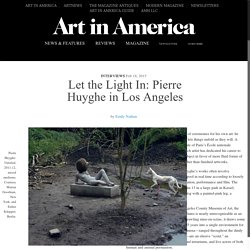
A self-declared biology fiend and a graduate of Paris’s École nationale supérieure des Arts Décoratifs, the French artist has dedicated his career to de-emphasizing the primacy of the art object in favor of more fluid forms of production, constructing “situations” rather than finished artworks. Time-based and context-contingent, Huyghe’s works often involve manipulated ecosystems—and they unspool in real time according to loosely delineated conditions, integrating installation, performance and film. Polona Tratnik homepage. Robertina Šebjanič. Art Orienté Objet. Synchronicity (2015) Robin Meier and Andre Gwerder during ArtBasel 2015 at Volkshaus Basel, Switzerland Curated by Marc-Olivier Wahler // Commissioned and Produced by Audemars Piguet Art Commission 2015 Synchronicity is an installation exploring the emergence of natural cycles and synchrony inside an artificial biosphere.
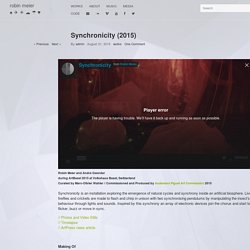
Live fireflies and crickets are made to flash and chirp in unison with two synchronising pendulums by manipulating the insect’s behaviour through lights and sounds. Inspired by this synchrony an array of electronic devices join the chorus and start to flicker, buzz or move in sync. #A.I.L – artists in laboratories, episode 25: Kira O’Reilly.
The new episode of #A.I.L – artists in laboratories, the weekly radio programme about art and science i present on ResonanceFM, is aired today at 4pm (London time.)
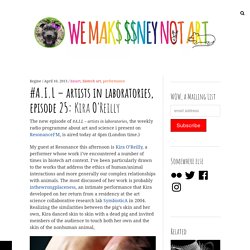
My guest at Resonance this afternoon is Kira O’Reilly, a performer whose work i’ve encountered a number of times in biotech art context. I’ve been particularly drawn to the works that address the ethics of human/animal interactions and more generally our complex relationships with animals. The most discussed of her work is probably inthewrongplaceness, an intimate performance that Kira developed on her return from a residency at the art science collaborative research lab SymbioticA in 2004. Realizing the similarities between the pig’s skin and her own, Kira danced skin to skin with a dead pig and invited members of the audience to touch both her own and the skin of the nonhuman animal, Kira O’Reilly, inthewrongplaceness, 2009. KAC. BioArt. Il s’agit d’un mouvement artistique récent, 2000 jusqu’à nos jours. Les bio-artistes (de « art » et « biologie ») travaillent sur l’être humain ou l’animal, sous l’angle de la modification des corps par un agent extérieur (gènes, éléments robotiques, etc).
Ils privilégient les outils numériques et cinématographiques. Le terme de Bio Art a été inventé par Edouardo Kac en 1997 en relation avec son travail Time Capsule . PATRICIA PICCININI. George Gessert. Un article de Wikipédia, l'encyclopédie libre. George Gessert est un artiste contemporain américain né à Milwaukee en 1944. Heaven+Earth+Joe Davis. BioArt Laboratories. Joe Davis Bio-Art. Choréogénétique. Choréogénétique ou l’art de faire danser l’ADN par François-Joseph Lapointe Soutenance de thèse sous la direction de Martine Époque de l’UQAM Avec comme évaluateur externe l’astrophysicien Roger Malina 840 rue Cherrier – Pavillon de Danse de l’UQAM au K-R380 Vendredi 20 avril à 10h Transgénèse des plus réussie pour François-Joseph Lapointe. En utilisant comme vecteur la créativité, il intègre ses trois passions- biologie, recherche et danse. Mylène Roy sa collègue de danse-yoga, dresse un beau portrait de cet ingénieux OGM bipède agile qui a le sens du rythme.
Olga kisseleva. Marta de Menezes. Artiste transmédia et féministe. Météorite narratif du BIO ART. Son oeuvre questionne le statut du CORPS dans la société. Ses sculptures, HYBRIDATIONS et autoportraits réinterprètent le rôle des nouvelles technologies. Špela Petrič.